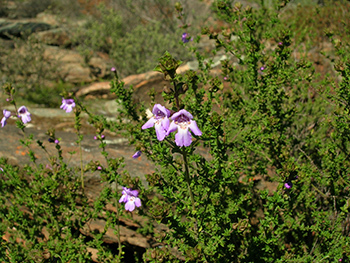Native plant - Monarto mintbush
- Fact sheet
- August 2015

Description
- spreading shrub <1m high
- branches covered in short, curled hair
- leaves are clustered, thick and hairless
- the base of the flower is mid-green with a red or maroon tinge
- petals are light purple, 10-12mm long, orange and dark purple dots on the inner side of the flower.
Ecology
- flowers from September to November
- grows on sandy loam and loam soils.
Conservation rating
Monarto mintbush is nationally endangered – approximately 600 plants remain in the Murraylands and Riverland region. There is also a population in the upper south-east of South Australia, at Mount Monster.
Threats
- fire (either too frequent or not frequent enough)
- grazing (kangaroos, stock and rabbits)
- small population size and low new plant survival
- weed competition.

Habitat
Found in tall shrublands or open woodlands, usually associated with rocky granite outcrops.
When present in tall shrublands, there are very few overstorey species present. The dominant species found in this habitat type is broombush (Melaleuca uncinata).
The undergrowth is typically dominated by scattered shrubs over native grasses, lilies and herbs.
In open woodland habitats, the overstorey is dominated by:
- mallee box (Eucalyptus porosa)
- blue gum (Eucalyptus leucoxylon ssp. leucoxylon)
- beaked red mallee (Eucalyptus socialis)
- narrow-leaf red mallee (Eucalyptus leptophylla).
The undergrowth is typically dominated by scattered shrubs over native grasses, lilies and herbs.
Distribution
Only two small, scattered populations in South Australia – at Monarto (near Murray Bridge) and around Mount Monster Conservation Park (within the park and on private land).
How you can help
Please be aware of native plants and help preserve them by:
- preventing damage caused by grazing
- preventing removal/illegal collection
- controlling weeds to reduce competition
- taking a photo instead of picking native flowers
- volunteering with the Murraylands and Riverland region or joining your local native vegetation group
- reporting any sightings of these endangered plants to our offices (contact details below).